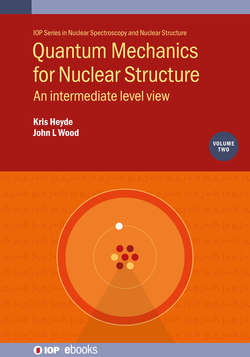Читать книгу Quantum Mechanics for Nuclear Structure, Volume 2 - Professor Kris Heyde - Страница 32
На сайте Литреса книга снята с продажи.
ОглавлениеIOP Publishing
Quantum Mechanics for Nuclear Structure, Volume 2
An intermediate level view
Kris Heyde and John L Wood
Chapter 2
Addition of angular momenta and spins
The coupling of spins and angular momenta is introduced at the simplest possible level: the coupling of two spin-12 particles. The concepts of reducible and irreducible representations are clarified. A thorough introduction to Clebsch–Gordan coefficients (CG coeffs) and the related Wigner or 3-j coefficients (3-j symbols) is given. Spin–orbit coupling is described. The interconnection between CG coeffs. and rotation matrices is presented. A brief introduction to recoupling coefficients—6-j and 9-j coefficients—is given. Tables of simple CG and 3-j coefficients are given in appendix A.
Concepts: direct, tensor, or Kronecker products; reducibility of a representation; irreducible representations (irreps); Clebsch–Gordan (CG) coefficients; Wigner or 3-j coefficients; CG series; irrep character; spin–orbit interaction and coupling; vector spherical harmonics; 6-j coefficients; 9-j coefficients.
The epitome of quantum systems possessing SO(3) and SU(2) symmetry is provided by quantum particles with angular momentum and spin. This naturally leads us to consider the coupling of spins and angular momenta in many-particle quantum systems. This is an essential part of the physics of molecules, atoms, nuclei and hadrons.
2.1 The coupling of two spin-12 particles
The simplest possible coupling in SU(2) is that of two spin-12 particles. This is realised, for example, in the ground state of the hydrogen atom where one is concerned with a proton and an electron (both spin-12 particles) in a state of relative motion with angular momentum zero (l = 0). Thus, the possible ground-state configurations of the hydrogen atom are completely described by
s=½,msp⊗s=½,mse=½,½p⊗½,½e,(2.1)
or
=½,½p⊗½,−½e,(2.2)
or
=½,−½p⊗½,½e,(2.3)
or
=½,−½p⊗½,−½e.(2.4)
These basis states, made up of the sp=12, mp=±12 and se=12, me=±12 basis states for the proton and electron, respectively, are in a form referred to as a direct product, tensor product, or Kronecker product.
Just as we considered the rotation of spin-12 particles in chapter 1, we can discuss the separate rotation of the proton and the electron in the four states, equations (2.1)–(2.4)
12mspR⊗12mseR=D(12)αp,βp,γp12msp⊗D(12)αe,βe,γe12mse,(2.5)
where αp, βp, and γp and αe, βe, and γe are the Euler angles describing the rotations of the proton and the electron ket states, respectively. These rotations can be viewed in the form
12mspR⊗12mseR=D(12)αp,βp,γp⊗D(12)αe,βe,γe×12msp⊗12mse,(2.6)
i.e. as transformations Dp(12)⊗De(12) on a four-dimensional space spanned by 12msp⊗12mse. The matrices representing Dp(12)⊗De(12) are 4 × 4. For example, if αp=0, γp=0, αe=0, γe=0, they have the form
D(12)(0,βp,0)⊗D(12)(0,βe,0)≔D(12,12)(0,βp,0;0,βe,0)≔cosβp2cosβe2−cosβp2sinβe2−sinβp2cosβe2sinβp2sinβe2cosβp2sinβe2cosβp2cosβe2−sinβp2sinβe2−sinβp2cosβe2sinβp2cosβe2−sinβp2sinβe2cosβp2cosβe2−cosβp2sinβe2sinβp2sinβe2sinβp2cosβe2cosβp2sinβe2cosβp2cosβe2,(2.7)
where the 4 × 4 matrix is generated from
D(12)(0,βp,0)=cosβp2−sinβp2sinβp2cosβp2(2.8)
and
D(12)(0,βe,0)=cosβe2−sinβe2sinβe2cosβe2(2.9)
in a straightforward way.
The proton and the electron in hydrogen experience a ‘spin–spin’ interaction through their magnetic moments: this results in a splitting in energy of the states, equations (2.1)–(2.4). Thus, transformations such as that described by equation (2.7) do not leave the energy of the hydrogen atom ground state unchanged. However, ‘rigid’ rotations with αp=αe, βp=βe and γp=γe, which preserve the relative orientation of the two spins, will leave the energy unchanged. In equation (2.7), for example, if βp=βe≡β then
D(12)(0,β,0)⊗D(12)(0,β,0)=cos2β2−sinβ2cosβ2−sinβ2cosβ2sin2β2sinβ2cosβ2cos2β2−sin2β2−sinβ2cosβ2sinβ2cosβ2−sin2β2cos2β2−sinβ2cosβ2sin2β2sinβ2cosβ2sinβ2cosβ2cos2β2.(2.10)
This matrix is reducible:
C†D(12)(0,β,0)⊗D(12)(0,β,0)C=12(1+cosβ)−sinβ212(1−cosβ)0sinβ2cosβ−sinβ2012(1−cosβ)sinβ212(1+cosβ)00001,(2.11)
